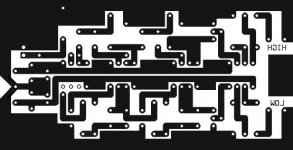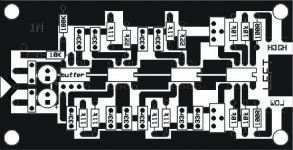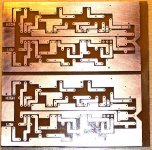Nrik,
Sorry to bother again, but just trying to think through what you said.
In other words, for the opamps in the filter stage, best to stick with something like the OPA2134, but for the output there is room for experimentation?
By the way, Rod also says that although he recommends the TL072 as "the most economical option... You may use any 8-pin dual opamp without concern" (throughout the board) -- the only caveat being that if using very fast opamps, the use of sockets could cause oscillation...
ivan: looks like nice work -- I'm a noob so I bought the PCB from Rod....
Sorry to bother again, but just trying to think through what you said.
In other words, for the opamps in the filter stage, best to stick with something like the OPA2134, but for the output there is room for experimentation?
By the way, Rod also says that although he recommends the TL072 as "the most economical option... You may use any 8-pin dual opamp without concern" (throughout the board) -- the only caveat being that if using very fast opamps, the use of sockets could cause oscillation...
ivan: looks like nice work -- I'm a noob so I bought the PCB from Rod....
Hi, guys
It's the first time that somebody apreciate my work, thank to everybody.
Well, because I'm novice in electronics, I use the "Express PCB" then use the PhotoPaint (corel) to improve the traces and finally to make the PCB, use Press'nPeel to transfer the picture to the copper. I have "Eagle" too, but to me is complicate.
If anybody need the hi-res pictures send me an e-mail.
Thaks to everybody
Iván Francisco
It's the first time that somebody apreciate my work, thank to everybody.
Well, because I'm novice in electronics, I use the "Express PCB" then use the PhotoPaint (corel) to improve the traces and finally to make the PCB, use Press'nPeel to transfer the picture to the copper. I have "Eagle" too, but to me is complicate.
If anybody need the hi-res pictures send me an e-mail.
Thaks to everybody
Iván Francisco
ssmith said:
ivan: looks like nice work -- I'm a noob so I bought the PCB from Rod....
I'm using a pair of Rod's PCBs, but I get really bad hum on one channel. I'm not sure if it's my implementation or a design flaw.
ssmith said:
In other words, for the opamps in the filter stage, best to stick with something like the OPA2134, but for the output there is room for experimentation?
You can use other opamps for the filterstage if you like. Just avoid the ones with bipolar input, like NE5532, LM833, etc.
But many people say that when used as a buffer like in this circuit, the benefit from very expensive opamps are not really that big.
So there is no need to buy the fastest most expensive video opamps you can find.
In my world the OPA2134 sounds great, and is pretty cheap, and I promise that you will get a great result using it anywhere in this circuit.
The output amplifier ( the one Elliot suggests as an add-on circuit with level-control - NOT the last opamp in the filtercircuit) can be anything. Here the it is okay to use NE5532 or LM833 or other bipolar input opamp, and here you can probably get better sound if you buy even better opamps like AD797, AD845 or THS4032 (watch out for the special feedback needed by the latter two and that these only come in SMD)...
But I'll just stick to OPA2134 or maybe OPA2604. There are some other threads in here that discusses wich opamps are best.
You can even substitute the whole output circuit with a discrete bufferamp with bipolars, FETS or tubes whatever you fancy - it is a regular bufferamplifier and not a part of the filter circuit itself.
ssmith said:
By the way, Rod also says that although he recommends the TL072 as "the most economical option... You may use any 8-pin dual opamp without concern" (throughout the board) -- the only caveat being that if using very fast opamps, the use of sockets could cause oscillation...
TL072 is a very old opamp, OPA2134 is newer and sounds much better.
He is basically right about the oscillation thing, but nowadays the fastest video opamps only comes in SMD, so I dont think you'll experience any problems with regular DIP8 opamps.
My suggestion to use sockets was only if you felt like experimenting with different opamps.
If you just want it to work, just solder the opamps in the PCB without sockets (with OPA2134
Or use sockets and you can change to a new opamp every week after reading on diyaudio.com about this f a n t a s t i c new opamp, spend all your time switching, listening and trying to determin wich one is the best...
I guess what I'm saying is....just use OPA2134 guys.
Like I said, bipolar input amps like the NE5332 will work for the filter stages too, you don't need to use a fet input opamp like a 2134 or TL072.
The input impedance is increased to approximately Rin*Av*Bf, where Av is open loop gain, Bf is the gain of the feedback network (always less than 1), and Rin is much greater than the parallel impedance of the feedback network.
P.S. This is coming from quick in my head analysis, so it may not be mistake free. Simply put, one can usually regard an opamp's input impedance as infinite so long as the closed loop gain is reasonably low.
The input impedance is increased to approximately Rin*Av*Bf, where Av is open loop gain, Bf is the gain of the feedback network (always less than 1), and Rin is much greater than the parallel impedance of the feedback network.
P.S. This is coming from quick in my head analysis, so it may not be mistake free. Simply put, one can usually regard an opamp's input impedance as infinite so long as the closed loop gain is reasonably low.
I was looking at the various designs that people use, and I am looking at the dirt cheap capacitors being used. In the tube world, A small change in capacitor quality has a large change on sound quality. I was going to use orange drop capacitors for this, does capacitor quality matter? what kind does everybody seggest?
The low value/voltage caps in active XOs are a lot cheaper than the relatively huge caps in passive XOs. Quite nice caps can be had for under a couple of dollars.
I've build my share of active XOs. The first was a dirt cheap experiment, using polyester caps and NE5532s. It sounded decent. I used polypropylene caps in the next XO - it sounded better, but the caps weren't the only change. I have also used Panasonic stacked polypropylene film, Wima MKP and FKP as well as some of Mouser's dirt cheap polystyrene caps. The 10% parts need to be chosen carefully from a large lot, so it ends up costing a bit more than you'd think.
Although I have never done a direct comparison without changing something else, I prefer polystyrene slightly over the stacked polypropylene caps which in turn I like better than the polyester. I still end up using cheaper polystyrene caps in the low end, due to space constraints. YMMV, etc.
I've build my share of active XOs. The first was a dirt cheap experiment, using polyester caps and NE5532s. It sounded decent. I used polypropylene caps in the next XO - it sounded better, but the caps weren't the only change. I have also used Panasonic stacked polypropylene film, Wima MKP and FKP as well as some of Mouser's dirt cheap polystyrene caps. The 10% parts need to be chosen carefully from a large lot, so it ends up costing a bit more than you'd think.
Although I have never done a direct comparison without changing something else, I prefer polystyrene slightly over the stacked polypropylene caps which in turn I like better than the polyester. I still end up using cheaper polystyrene caps in the low end, due to space constraints. YMMV, etc.
Adding volume control to P09
Can anyone recommend a good method of adding volume control to the P09? I was thinking of cutting a few traces and installing a dual gang 10k log pot between U1 and U2/U5... Would this work? If not, I will likely build a P88 or P97 but it seems that this would add unnecessary opamps to the signal path.
Can anyone recommend a good method of adding volume control to the P09? I was thinking of cutting a few traces and installing a dual gang 10k log pot between U1 and U2/U5... Would this work? If not, I will likely build a P88 or P97 but it seems that this would add unnecessary opamps to the signal path.
- Status
- This old topic is closed. If you want to reopen this topic, contact a moderator using the "Report Post" button.
- Home
- Amplifiers
- Solid State
- Active Crossovers, my flavor of the month


